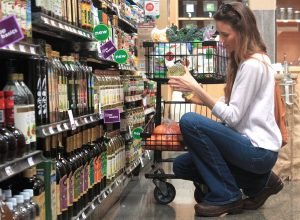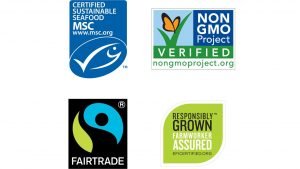
When we visit the grocery store, we’ve become accustomed to a dizzying array of options. There are food labels touting everything from food safety to environmental and ethical standards. Making the best decision for your family, your health and the good of the planet is important, but how can you possibly keep track of what all these labels really mean? Behind the label: Decoding certifications in the shopping aisle.

Voting with your wallet

Today’s wired world allows us to be more conscious of the impacts of our choices than ever before. Shopping isn’t just about putting food on the table. It’s a daily opportunity to support the kind of world we want to live in. Our actions and what we choose to buy can impact not only the planet’s future, but our social economy as well.
A 2017 study by Cone Communications reported that 60 percent of Americans believe businesses can be key drivers for social and environmental change. Whether it’s phasing out plastic bags and straws or carrying more ethically traded products, businesses are showing consumers that they are listening.
Businesses aren’t doing this just because you asked; they’re doing it because it’s the right thing. Many of them are putting their values on full display in the form of labels that make it easier for you to navigate the shopping aisle.
“As shoppers we are often in a hurry, so much so that we might not even be aware of how quickly we make a decision. That’s where clear labeling can help,” said Rebecca Walker Reczek, professor of marketing at Ohio State University. “Without it you’d need to research each product and the time can add up.”
The truth behind the labels
So what gives? Are organic and natural the same thing? Does a green label mean it’s better for the environment? What does "fair trade" really mean? These are just some of the questions many consumers are asking when they make their way down the grocery aisle.
Most of us are aware of those little labels on our food, but we often don’t understand what they mean. Like any choice, the key is education. To shop in accordance with our values, we must understand what the label stands for and how it’s been verified. And yes — verification matters. Marketing savvy and great design can create convincing packaging and badges that represent a company’s promise, but often they aren’t based on rigorous standards.
On the other hand, certification labels mean that an independent organization has audited and checked that a company is following a standard set of rules — whether it’s fair trade, responsible fishing, GMO avoidance or better treatment of workers.
For example, the USDA organic label means that an independent organization has audited the farmer to make sure they abide by national organic standards. On the other hand, the term ‘natural’ has no set definition or standards. Neither the FDA nor the USDA has set rules for this term. Pure, natural, green, direct trade — all these terms conjure an image, but are not audited and don’t refer to any established standard. Essentially, they are just words.
A guide to the goods
Everyone has a right to know what is in their food and where it comes from. Look to these certifications to guide your next shopping trip:
* Fairtrade — The Fairtrade certification ensures safe and fair working conditions, prohibits child labor and provides farmers and workers with a fairer price or better wages. Fairtrade products originate in developing and least developed countries where farmers and workers are often marginalized.
Where found: Coffee, chocolate, bananas, sugar, avocados, tea and more
* MSC Certified — By choosing seafood with the MSC blue fish label you are supporting independently certified sustainable fisheries. Their good management practices help ensure fish stocks and habitats are healthy and fishing community livelihoods are secure.
Where found: Wild caught fish and seafood, fish oil supplements, pet food
- Responsibly Grown, Farmworker Assured — The EFI-certified label indicates that the workers who harvested your food are treated with respect, compensated fairly and engaged to identify problems that impact the safety of your food.
Where found: Fresh fruits and vegetables
* Non-GMO Project Verified — The Non-GMO Project Standard is North America’s most rigorous and reliable standard for GMO avoidance, set apart by its transparency, trustworthiness, ongoing testing and third-party status. The best way to avoid consuming GMOs is to look for the butterfly.
Where found: Dairy and meat products, fruit and vegetables, snack foods, vitamins and supplements, oils and more
Food is a basic necessity, but it is also a conscious choice shaped by our values and our lifestyle. Shop your values on your next shopping trip. To learn more about these certifications and continue the conversation, visit www.fairtr.de/TruthBehindLabels.
Find this Article and others like it on #SteemIt. Follow CoolPeopleIFB and get Paid to Share & Socialize.
Posted from my blog with SteemPress : https://pitmasterandthecook.net/behind-the-label-decoding-certifications-in-the-shopping-aisle/

Hi! I am a robot. I just upvoted you! I found similar content that readers might be interested in:
http://bluewaterhealthyliving.com/the-truth-behind-food-labels1/
Downvoting a post can decrease pending rewards and make it less visible. Common reasons:
Submit